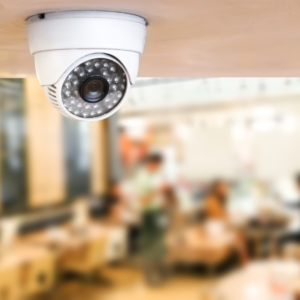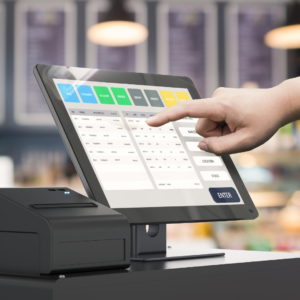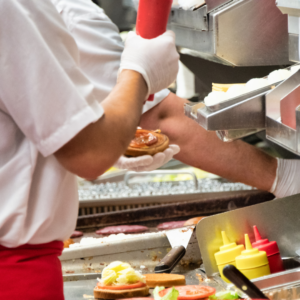Deciding to secure your restaurant with a security camera system involves careful consideration of various factors. It’s not just about where to install the cameras but also about understanding your business goals and security priorities.
In this guide, we will explore where to start when looking into installing a security camera system in your restaurant:
- Security Camera Placement Based on Business Priorities
-
- Safety
- Loss Prevention
- Operations
- Types of Security Cameras
- Site Surveys
- Factors to Consider When Installing Security Cameras
- Analog Security Cameras vs. IP Security Cameras
- More Visibility with Managed Video
- Importance of an End-to-End Solution
Where should I install security cameras in my restaurant?
Defining your goals is key in deciding where and how much to invest in security cameras for your restaurant. Whether it’s emphasizing financial oversight, prioritizing safety, or enhancing operational efficiency, a clear focus guides strategic camera placement. This ensures your investment aligns with your objectives for the security and success of your establishment.
Deciding to invest in security cameras in your restaurant starts by focusing on three main things—Safety, Loss Prevention, and Operational Efficiency. This way, you create a security setup that supports your business goals. Let’s explore each priority, breaking down the details that will shape your restaurant’s security.
1. Safety: Protecting What Matters
Safety isn’t just a checkbox; it’s the start of creating a welcoming and secure environment for both customers and staff. With safety as a top priority, consider installing security cameras in these specific areas of your restaurant:
 Entrances and Exits: These are the gateways to your establishment. Cameras here serve as vigilant guardians, monitoring who comes and goes, and enhancing overall security.
Entrances and Exits: These are the gateways to your establishment. Cameras here serve as vigilant guardians, monitoring who comes and goes, and enhancing overall security.- Slip-and-Fall Areas: Identify and focus on spots prone to accidents. Security cameras help in recording that policies and procedures are being followed, like using a wet floor sign after a spill, contributing to a safer environment. According to AM Trust Insurance, every year, over 4 million restaurant workers and guests get hurt in slip-and-fall accidents, costing the food service industry more than $2 billion annually. Capturing footage in these areas is important for safety but also for possible lawsuits that could happen in the future.
- Dining Area / Bar: Security camera systems are crucial in the main dining and bar area due to consistent foot traffic, financial transactions, and the potential for “dine and dash” situations. Given that customers spend a significant amount of time in this area, it’s recommended to install security cameras that blend seamlessly with the decor. Low-profile dome security cameras are commonly preferred for their unobtrusive design in the dining and bar space.
By strategically placing cameras in these areas, you prioritize the safety of your patrons and enhance the overall security posture of your restaurant.
2. Loss Prevention: Safeguarding Your Restaurant Profits

The key to successful management of any business is preserving its financial health. The installation of security cameras will aid in preventing financial loss while ensuring the well-being of your establishment. Here’s a closer look at locations where you may want to install security cameras if your business focus is on loss prevention:
- Safe Access: Security cameras watching the safe, act proactively to deter unauthorized access. This prevents attempted theft or tampering, safeguarding your financial assets from potential loss or misuse.
- Office Oversight: In addition to having surveillance focused on the safe, it’s equally crucial to have a clear view of the office space, where financial transactions such as counting down a till occur. Security cameras in the office provide continuous supervision and deter fraudulent activities.
- Cash Registers: Position your security cameras to monitor cash registers, detecting potential credit card misuse, discount abuse, or employee cash theft. With video footage and receipt information, see the full picture of each transaction.
- Other Cash Handling Areas: For other cash handling areas, security cameras offer continuous oversight, deterring fraudulent activities. This proactive monitoring identifies and addresses dishonest practices like skimming or mishandling of funds..
3. Operational Efficiency: Streamlining the Process
Improving how your restaurant works, or its operational efficiency, is like making sure all the gears in a machine are well-oiled and running efficiently. In the world of security, cameras monitor important areas that record day-to-day activities to make sure everything is running smoothly. Let’s zoom in on a few crucial places where you’ll want to install security cameras in your restaurant if your focus is on operational efficiency:
 Security Camera Systems in the Kitchen: The kitchen is the heart of your restaurant, and keeping it running smoothly is critical. Security cameras strategically positioned in the kitchen assist managers in monitoring whether employees adhere to safety protocols, maintain cleanliness standards, and prepare food correctly and promptly.
Security Camera Systems in the Kitchen: The kitchen is the heart of your restaurant, and keeping it running smoothly is critical. Security cameras strategically positioned in the kitchen assist managers in monitoring whether employees adhere to safety protocols, maintain cleanliness standards, and prepare food correctly and promptly.- Food Handling: How food is handled is essential for safety, food quality, and brand reputation. Security cameras overseeing food handling areas ensure that processes (like temperature checks, proper food storage, regular handwashing, wearing gloves, and more) are followed correctly. This not only maintains high hygiene standards but also helps in case any issues need reviewing or improving.
- Optimizing the Drive-Thru: The drive-thru is a fast-paced area where efficiency is key. Cameras placed here help keep an eye on the orders, making sure they’re accurate and that customers are being served quickly. As the drive-thru experience continues to grow for most restaurants, making sure cameras are positioned correctly in the drive-thru can improve the speed of service and order accuracy.
“The main factor technicians need is a lot of pictures of the location so they can determine where the key areas of the site are and what type of security cameras need to be installed, “ says Chris Crawford, senior manager of the project management office at Envysion.
What type of security camera should I buy for my restaurant?
We recommend these five styles of security cameras for restaurant establishments:
- Dome Cameras
- Turret Cameras
- Bullet Cameras
- Fisheye Cameras
- Pinhole Cameras
If you’re interested in learning more about the different types of security cameras, check out our buying guide: Best Security Cameras for Businesses
Do I really need a site survey before installing a security camera system?

We highly recommend a site survey for many reasons. Deciding to do a site survey for your restaurant ensures you receive a tailored and accurate quote for your security camera system. By having an installer visit your location, they can assess specific factors such as:
- Building design and layout
- Ceiling height and material configurations
- Potential challenges unique to your establishment
In today’s mobile-friendly world, site surveys can be conducted virtually by capturing clear pictures, such as both the inside and outside of the building. This allows the installer to create a more personalized quote without the need to be physically present in the restaurant for the survey.
Rather than relying on generic estimates, a site survey ensures that the proposed security solution is cost-effective and customized for your restaurant, making it a valuable step in the security system installation process.
What factors should I consider when installing security cameras in my restaurant?
Installing a security camera system for your restaurant has various components that impact the overall cost, such as building design, equipment choices, and installation challenges. It’s important to carefully consider these elements to ensure the system meets your specific needs and budget.
For the camera system to operate efficiently, operators should be aware of several elements before initiating the installation process. “One of the most important factors of a new installation is a good design because it allows us to capture the things the business is trying to optimize and capture their goals,” says Crawford. For instance, if a restaurant is trying to prioritize loss prevention, then cameras should be placed with a view of money-handling areas such as cash registers or near the safe.
Here’s a breakdown of key considerations:
1. Building Design: The layout and design of the building influence camera placement and wiring complexity, impacting overall costs.
2. Square Footage: The size of the building directly impacts the number and types of cameras needed, leading to variations in the total cost.
3. Ceiling Height: Taller ceilings may require extra equipment like lifts, impacting installation costs.
4. Ceiling Type: The type of ceiling and material affect cable concealment. Open ceilings with exposed beams pose challenges, potentially affecting installation costs.
5. New Construction: Ensuring a smooth installation in new construction involves coordinating with technicians and the construction team. This may mean more specific scheduling, possibly leading to additional costs.
6. Building Location: Rural locations may incur higher costs due to travel expenses, contrasting with city installations.
7. Camera Count: The number of cameras directly correlates to the overall cost, as more equipment and wiring increase the complexity of the installation process. Having more cameras means more cables, leading to an increase in both installation time and costs.
8. Operating Hours: Opting for overnight installation to avoid disruptiveness during customer hours may result in additional labor costs.
9. Outdoor Cameras: Installing outdoor cameras requires additional hardware, like external mounts, which correlates to more labor and time, influencing the overall project cost.
10. OSHA Compliance: Technical work at taller heights will require a spotter to stay compliant with OSHA regulations, potentially necessitating additional safety measures and costs.
11. Low-Voltage Camera Codes: It’s important to follow specific rules about low-voltage camera installations, as they can affect how the cameras are set up and may impact costs. Keep in mind that these rules can vary by state.
12. Equipment Installation: The more cameras, cables, and views desired, the higher the overall cost, as complexity increases.
13. Camera Maintenance: Ensuring your cameras work well involves regular checks and lens cleaning. If technician maintenance is needed to replace lenses due to exposure to outdoor weather or indoor elements like kitchen grease or moisture, this will add extra costs to your security camera system.
14. Analog vs. IP Equipment: Analog equipment is pricier because it’s older and delicate, requiring careful handling. On the other hand, IP cameras are more budget-friendly, come with advanced features, and are easier to troubleshoot. For a full comparison and breakdown of Analog vs. IP security cameras, click here to read our guide.
For expert guidance and to prevent surprise costs, consider consulting with security camera solution specialists such as Envysion. Our dedicated support and consultants are here to review your needs, confirm necessary additions, and ensure your camera system aligns with your restaurant’s unique requirements and budget.
QSR Magazine Featured Read: What Restaurants Should Know Before Installing a Security Camera System
More Visibility into Your Restaurant with Managed Video
When setting up security cameras in your restaurant, select a system that easily integrates with your point of sale (POS) system. This connection is important because it combines transaction data with video footage, giving you valuable insights into your business.
A seamless managed video integration allows for better day-to-day monitoring, more details for investigations, and improved loss prevention tracking. Picking a security camera system that syncs with your POS system strengthens your restaurant’s loss prevention efforts and offers a powerful tool to manage and oversee your daily operations with more visibility.
An End-to-End Solution for Your Restaurant’s Camera System
Choosing an turn-key security camera and managed video company is important for your restaurant.
- It ensures a seamless and efficient experience as one company handles the entire process, from providing cameras to installation, technical support, customer support, and maintenance. This approach guarantees compatibility and reliability, simplifying the setup and establishing a consistent support system.
- Additionally, having a dedicated technical support team familiar with your system facilitates quicker issue resolution, minimizing downtime and enhancing the overall effectiveness of your restaurant’s security infrastructure.
Investing in an end-to-end solution transforms your security system from a one-time installation to an ongoing, well-supported solution tailored to the unique needs of your restaurant. At Envysion, we provide an end-to-end security camera solution for the restaurant industry. Eliminate the time suck from managing this complex project and lean on the experts! From offering top-quality security cameras to taking care of the setup and ongoing support, our security solution experts ensure your system is working smoothly. Envysion’s approach ensures your security setup is more than just a one-time thing – it’s a reliable, tailored solution for your restaurant’s unique needs.
Conclusion
Through this guide, we hope you’ve gained valuable insights into things to consider when deciding to install a security camera system in your restaurant. From understanding the initial steps in the installation process to identifying the best camera placements and exploring various camera types, and factors that go into quoting your building for installation, you’re set up for success to ensure your security camera system fits the unique needs of your restaurant.
Ready to learn more about the best end-to-end security camera system for your restaurant’s security? Envysion offers an all-in-one solution, from cutting-edge cameras to hassle-free installation and ongoing support. Contact us today.
